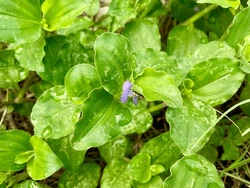Commelina erecta, commonly known as the erect dayflower or whitemouth dayflower, is a fascinating and resilient perennial plant. Found across the Americas, Africa, and parts of Asia, it thrives in diverse environments, from sandy dunes to disturbed grounds. In this blog post, we’ll explore its key characteristics, ecological importance, medicinal uses, and how to care for it in your garden.
What is Commelina erecta?
Belonging to the Commelinaceae family, Commelina erecta is a herbaceous plant with a striking appearance. It grows upright and can reach heights between 20 to 40 cm. Its fleshy green leaves are lance-shaped, and its delicate blue flowers open only during the day, hence the name “dayflower.” The plant reproduces via seeds and underground rhizomes, making it incredibly adaptable to various conditions.
Habitat and Distribution
Commelina erecta is native to many regions, particularly in North and South America, and can be found in savannas, grasslands, and even urban environments. It’s a hardy plant, often growing in sandy soils or areas disturbed by human activity. This ability to thrive in less-than-ideal conditions contributes to its widespread distribution.
Ecological Importance
While often considered a weed in gardens, Commelina erecta plays an important role in the ecosystem. Its flowers attract a range of pollinators, including bees and butterflies, supporting local biodiversity. The plant also serves as a ground cover, helping to reduce soil erosion in areas where it is naturally established.
Medicinal Uses of Commelina Erecta
Historically, Commelina erecta has been used in traditional medicine. Its leaves and stems are known for their anti-inflammatory and astringent properties. In various cultures, it has been used to treat conditions such as sore throats, burns, and wounds. The juice of the plant is sometimes applied topically to alleviate skin irritations, though more research is needed to confirm these benefits scientifically.
How to Grow and Care for Commelina Erecta
If you’re interested in growing Commelina erecta in your garden, here’s what you need to know:
Sunlight: The plant thrives in full sun but can tolerate partial shade.
Soil: It prefers well-drained soil, although it can adapt to sandy or even rocky soils.
Watering: It requires moderate watering. Once established, the plant is quite drought-tolerant.
Propagation: Commelina erecta can be propagated through seeds or by dividing the rhizomes.
While it may be considered invasive in some areas, it can be a beautiful addition to native plant gardens, xeriscapes, or pollinator-friendly spaces.
Conclusion
Commelina erecta is more than just a common wildflower or garden weed. With its ability to thrive in harsh environments, support local wildlife, and even offer medicinal properties, this humble plant deserves recognition. Whether you’re a gardener looking to add resilient plants to your collection or a nature enthusiast curious about local flora, Commelina erecta is a fascinating plant worth appreciating.
By understanding its role in nature and learning how to manage it in your garden, you can contribute to a healthier and more biodiverse environment.

1 Comment
Wow very informative article, thanks for sharing this